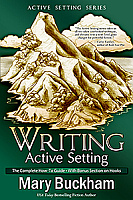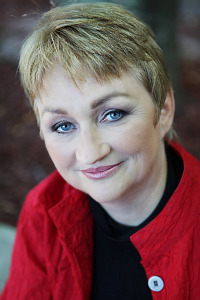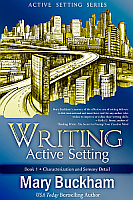I’m in San Antonio this week, presenting at the Romance Writers of America National Conference. But never fear, you’ll be in great hands while I’m gone. *smile*
I’m thrilled to announce that USA Today bestselling author Mary Buckham will be taking over my blog this week! Woo hoo!
Although Mary and I “knew” each other from Twitter before, we didn’t get a chance to connect until I met her in person at the Desert Dreams Conference this past spring. Mary was the featured speaker at Desert Dreams, giving a half-day presentation on writing “active” settings.
(In other words, this week, we’ll all get the benefit of conference-quality information, even though I can’t fit you into my suitcase. *grin*)
Before I turn my blog over to Mary, I want to tell you a bit more about why I was so excited to attend her presentation in April. Way back when I was a newbie writer, setting descriptions were my nemesis…
My Struggles with Writing Descriptions
In my first attempt at an original story, I included—I kid you not—several pages of dry “let me tell you everything the character sees” description. Yikes!
Some of the classics and literary novels can get away with languorous, poetic descriptions that call attention to the language itself or that provide static information just for its own sake. Most of us, especially those of us who write genre fiction, can’t make that approach work.
Our readers come for the story, not the language, so they want the story to keep moving. While our readers do appreciate lovely writing and language, we can’t “pause” the storytelling for a paragraph or more of static description. Their imagination wants movies, not a still life painting.
The trick to sharing setting information (which our readers do need) without dragging down the pace is to write active descriptions. Active descriptions let the reader imagine the setting in their mind, keep them anchored in the story, and slip in information so seamlessly that they never realize they’re reading descriptions.
Enter the fabulous Mary Buckham. She’s an expert on writing active descriptions. Her presentation at Desert Dreams was fantastic, and when I asked her here for a guest post on this tricky aspect of writing, she stepped up with an even better offer: two guest posts!
Today we have Part One, and come back Thursday for Part Two. Take it away, Mary!
*****
Why Writing Effective Setting Description Is Harder than You Think
Want to know one of the biggest hurdles to writing Setting that matters to a story? Forgetting to write the Setting from the POV (Point of View) of your character.
Too many times I see newer writers, and even more experienced ones, describing a room or street or a town based on how they see it, not how their character sees it.
Think about it a moment. Do you see a messed up bathroom the same way as your significant other? Or a teenage boy? Or someone who’s never had a bathroom all to themselves before?
Settings Need a Point of View
Instead of simply placing a character into a Setting ask yourself what matters to this character here, if anything?
Someone running through a room with someone chasing them is not going to notice the type of furniture or what knick knacks are on a mantle place. They’re going to be looking for a place to hide or an object to stop the person chasing them.
A woman who’s entertaining her possible mother-in-law for the first time in her one-room apartment is going to be noticing a whole lot of different things than her future in-law, especially if they come from a different background, social strata or even area of the country.
Using a Point of View Helps Connect Readers to the Character
Create a deeper connection between the reader and your character by revealing some of these all too telling insights. Keeping in mind of course that a little can go a long way.
Think in terms of what’s important for the reader to know about the Setting for the sake of your story and then what your POV character would notice. Put yourself deep into your character’s POV instead of skimming the surface and revealing nothing, unless nothing matters to them.
Setting can really enhance your story or work against what you want your reader to experience. Use your Setting to show more about your character for a richer, deeper experience.
How a Deeper Point of View Enhances Our Descriptions
Let’s look at an example approaching the Setting from a rough draft version to the final version.
First draft:
The wardens led me to a room and left me there.
Pretty bland description. The reader is not deep into this character’s POV because the character does not experience the room. There is no Setting so the reader is kept at arm’s length.
Note: Showing the room through deeper POV allows the reader to experience the room on a more immediate level. The reader is in the room with the character.
Second Draft:
I’m conducted to a room and left alone. It’s the richest place I’ve ever been in.
Better because now we’re given a little more insight into what the POV character is feeling based on the response to the room. But we still have no idea why the character feels this way. Nor can we see the room. Plus it’s straight telling, no showing.
Final Draft:
Once inside, I’m conducted to a room and left alone. It’s the richest place I’ve ever been in, with thick deep carpets and a velvet couch and chairs. I know velvet because my mother has a dress with a collar made of the stuff. When I sit on the couch, I can’t help running my fingers over the fabric repeatedly. It helps to calm me as I try to prepare for the next hour. The time allotted for the tributes to say goodbye to their loved ones. — Suzanne Collins — The Hunger Games
Here we have more Setting details that allow the author to show some characterization of the POV character, reveal emotions based on her interaction with this room, and all by adding just a few more details of Setting. Not too many details because that’s not the intention of the scene, but enough to start showing you as a reader that this character is out of her comfort zone and grasping at anything that can make her world normal again.
*****
Thank you, Mary! My guest post by Janice Hardy shared how a deep point of view can fix most of our writing woes, and this tip reiterates the importance of that technique. Don’t forget to check out the second part of her post on Thursday too!
As I learned in Mary’s workshop, when we use deep POV to write active descriptions, our story’s settings can perform double or triple (or more) duty. We can make those formerly dry descriptions work harder and smarter.
Per my notes from Mary’s workshop, setting can:
- show characterization (what do they notice or care about?)
- show sensory detail (what does the character see, hear, smell, touch, etc.?)
- show emotion (what’s the mood or tone for the character (or the reader)?)
- show conflict (how does the character respond to the place?)
- show backstory (how does the character feel about their surroundings?)
Notice how those aspects of descriptions center on the character. We need to use their POV to include details that matter. And those details will help the setting come to life in our readers’ imaginations.
To be intentional with the descriptions we write, we need to think about:
- What setting elements do we want to reveal?
- What does the POV character think about the setting—and why?
- What emotions do we want to bring out?
 If you want more tips like these, check out Mary’s Writing Active Setting series. The books go into even more detail than she can cover in her workshop.
If you want more tips like these, check out Mary’s Writing Active Setting series. The books go into even more detail than she can cover in her workshop.
She analyzes published examples of descriptions that work, as well as gives before and after examples that illuminate how much active settings can make our stories come alive. The complete set includes a chapter on each of those five ways I listed above for how we can put our settings to work and adds several more methods for how to force our descriptions to pull double and triple duty.
*****
 USA Today bestselling author Mary Buckham writes the Amazon best selling WRITING ACTIVE SETTING series (in e-format and now in book form) as well as Urban Fantasy w/attitude.
USA Today bestselling author Mary Buckham writes the Amazon best selling WRITING ACTIVE SETTING series (in e-format and now in book form) as well as Urban Fantasy w/attitude.
Love romance, danger & kick-ass heroines? Find it in her Invisible Recruits series: www.MaryBuckham.com or www.InvisibleRecruits.com.
Writing Active Setting: The Complete How-to Guide with Bonus Section on Hooks Box Set by Mary Buckham in e-book or print versions at your nearest online bookstore!
*****
Mary graciously agreed to hang out in the comments while I’m away, so feel free to ask any questions you have for her. She’ll stop by during the the week and do her best to answer. *smile*

Mary wants to hear from you about what you think might be the second biggest stumbling block in effectively using Setting in a story. Any thoughts?
As a special treat from Mary, one lucky commenter will win a free e-copy of WRITING ACTIVE SETTING Book 1: Characterization and Sensory Detail! Yay! This is Book One from her complete series.
Have you ever struggled with writing active, non-dry, non-static descriptions? What aspect of writing descriptions is most difficult for you? If you’ve improved your descriptions over the years, what tip was most helpful? Are you able to make your setting descriptions work double and triple duty? Do you have other tips to share on writing effective setting descriptions?

